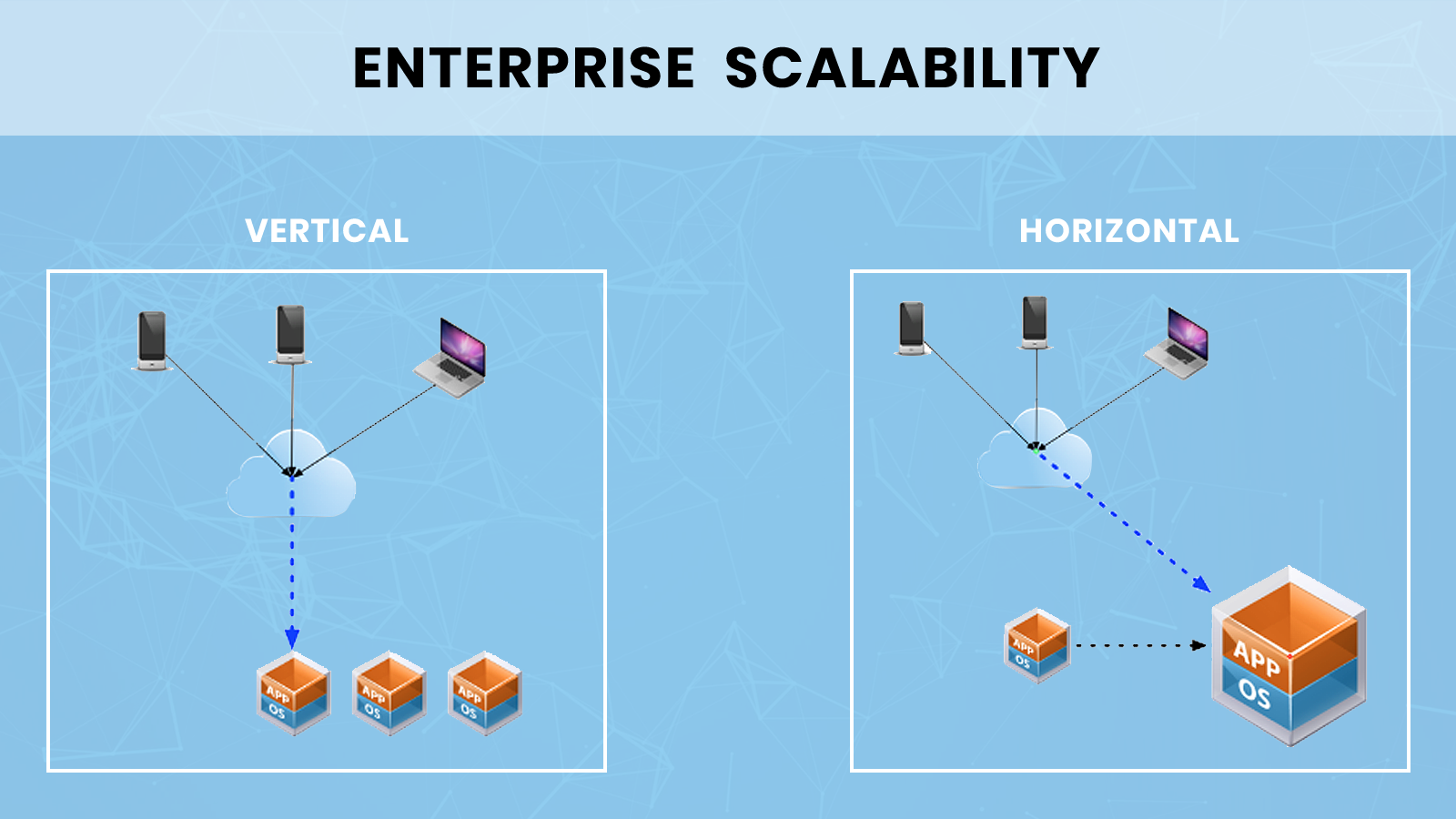 Entrepreneurial developers and startups roll out a small service that is delivered from their servers. These new enterprises begin with the hope that one day their services or applications will rule the world and emerge as one of the most popular things online.
Entrepreneurial developers and startups roll out a small service that is delivered from their servers. These new enterprises begin with the hope that one day their services or applications will rule the world and emerge as one of the most popular things online.
When that day finally comes, a single servers or a small cluster of machines will not be fit to handle such a huge workload. That is where scaling steps in. If an enterprise needs to execute its application on a large scale, it will have to invest time and resources on scaling in cloud computing.
Scaling on-premise infrastructures is challenging for an enterprise. During scaling, a business has to plan well for handling peak capacity. Besides planning, it has to wait for equipment arrival, configure software and hardware, and hope that it gets everything right at once.
However, when a business deploys its application on the cloud, it can successfully surmount these challenges. If and when a business plans to execute its application on a large scale, it will have to factor in scaling in cloud computing from the get-go.
So when it comes to accomplishing scaling, it comes down to two different approaches. The first one is vertical scaling, and the other one is horizontal scaling.
Discovering Horizontal Scaling
A business has to make its infrastructure shrink or grow. That is how the company’s entire ecosystem will be prepared for meeting a specific demand for request execution. For this reason, scaling-out is a traditional approach while running on the cloud.
You can think of horizontal scaling as a common railway system that is supposed to transport more goods daily. So, for coping with that sort of demand, this railway system will have to add locomotives for enhancing the overall throughput.
Here is one other example explaining horizontal scaling. Suppose a business has a web application that is needed to serve requests coming from the public internet. Now, once the number of requests increases, the web server will eventually succumb. This limit will define the total number of requests or the amount of traffic the application can handle anytime. That is when the business will have to add more and more servers for handling a specific load.
Of course, a business cannot expect to add any other instance without putting some extra efforts in the background. Now, setting up these background tasks can be time consuming and complex; that is why several cloud providers are there. These service providers will make their cloud platforms simple to use. That is not all since these providers will even give an enterprise specific autoscaling tools. Through these tools, a business can easily and quickly scale in or out based on, for instance, its CPU optimization levels.
Exploring Vertical Scaling
This form of scaling requires a business to add more resources (DISK, RAM, CPU, etc.) to its server (application server or database) as on demand. Most commonly, vertical scaling is used in products and applications of mid- and small-sized companies.
The most common way of achieving vertical scaling is by buying an expensive piece of hardware and using it as a virtual machine hypervisor. This format of scaling usually refers to upgrading server hardware. A few reasons explaining the importance of vertical scaling include amplifying RAM/CPU, increasing IOPS (input/output operations), and enhancing disk capacity.
Let us reconsider the example of the railway system that we used for explaining horizontal scaling. In this case, the number of goods will grow with the locomotive along with its parts. That means in vertical scaling, a railway system (the enterprise) will replace its engine (the CPU if there is just a single instance) with the one having more horsepower.
So, with vertical scaling, the business need not create additional copies of its applications. Instead, it will have to add more and more resources to super-size the whole infrastructure. Nevertheless, after deploying virtualization, whenever the focus is on delivering an improved performance, the risks of downtime will be way higher than deploying horizontal scaling.
Achieving Scalability Through Horizontal Scaling Or Vertical Scaling
Scalability plays an important role in enabling businesses to scale up or down for handling the changing market demands. Now that there are two scaling formats, picking the one that fits an enterprise’s business model is important.
So, here are the advantages and disadvantages of both the forms of scalability. Let us start with horizontal scaling, first.
Horizontal Scaling Upsides
Infinite Scaling
Theoretically speaking, if an enterprise’s application can scale horizontally, it may use unlimited instances. This way, the system can not only serve an unlimited number of requests but also enable limitless growth.
Tools
Cloud providers of today are very accommodating to this specific deployment architecture. Most cloud providers have the right support tools in place that can be used from day one by enterprises that want to use horizontal scaling. As this specific architecture enjoys the support of many cloud providers, an enterprise need not have extensive knowledge of configuring the deployment options. Overall, these tools make it simple and quick to scale applications.
Horizontal Scaling Downsides
Architectural Design
Designing an application properly with regards to this deployment architecture is challenging. While designing its application, a business will have to factor in a number of elements; among these elements, most of them are related to dealing with security (SSL) and preserving state (persistence/cookies). Additionally, a serious architectural design is needed for creating an application that can handle 100 percent horizontal scaling.
Databases And Persistence
It is a no-brainer that an application will never exist in a vacuum. In general, a business will need to store the information about its customers; this information will be related to customers’ purchasing date and why they made the purchase in the first place. These and many other similar details will go into a database. Now depending on the database type that a business uses, there may be additional architectural work needed. Through this work, an enterprise will ensure that not just its application scale but even the application’s data layer scales. This is not at all a simple task and will get complicated only when the data expands over a number of locations, tiers, and regions.
Vertical Scaling Upside
Architecture And Software Remain The Same
An enterprise need not make specific changes to the process of writing or designing its application. Referring to that same train analogy, if a business upgrades just a single locomotive, then it will not need to change the way good (load) distribution is done.
The same thing is true for scaling up a resource. In this case, the enterprise will need to just add more RAM or CPU horsepower or disk space. By doing so, a business will seamlessly improve its network throughput. The bottom line is that a business will not have to make any specific modification to the application; instead, it will just have to modify the underlying instance and even its size.
Vertical Scaling Downsides
Finite Scale
While performing vertical scaling, there is a specific growth limit that a business has to abide by. At a point, there may be well-defined limits telling an enterprise about its cart’s capacity. Likewise, the architecture will even set limits about how many horses can pull that cart. Most of the times, the enterprises rely on adding CPU, RAM, and disk space to a specific instance. But in these cases, an enterprise can only go so far until the whole application ultimately becomes the bottleneck in itself.
Downtime
For adding more resources, a business will have to bring its application down. There are very minimal servers allowing a company to add different hardware resources on the go. Plus, as expected, these servers are expensive to use. Similarly, a business will not be able to resize an instance while it is being executed; that means the instance has to be powered off, first. The only solution to this downside is that the enterprise will have to plan a specific maintenance window. When such a maintenance window is in place, it becomes obvious that the enterprise will have enough running capacity for accommodating the existing load.
Scale With The Right Partner
For making scalability a reality, a business will have to find the right cloud computing service provider. That is where Flexsin Technology will streamline this transformation journey toward achieving scalability. This company has the expertise and experience to let a business attain peak performances while using horizontal scaling or vertical scaling or both within cloud ecosystems.


 Ankur
Ankur

